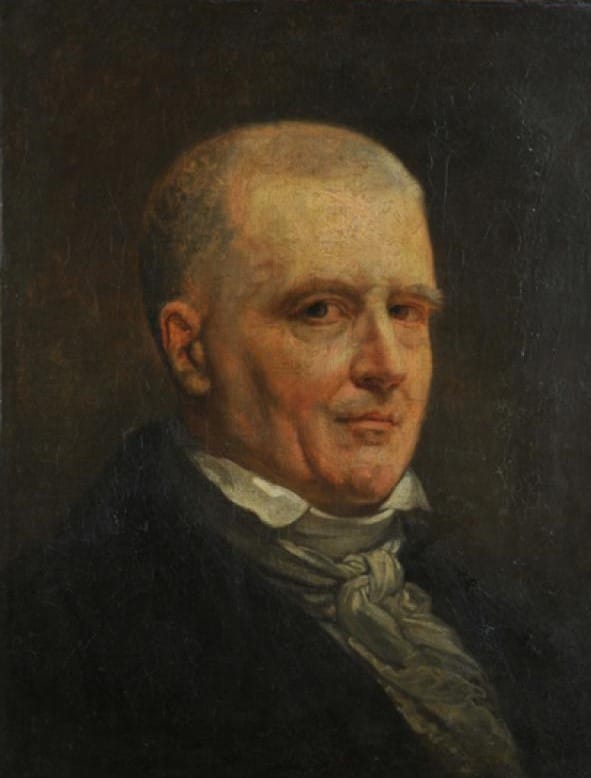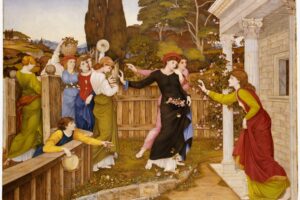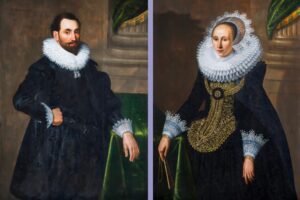Imagine stepping back in time to a sun-dappled garden in 18th-century France. The air is warm, filled with the scent of blooming flowers and the soft rustle of leaves. This is the enchanting world captured in The Swing, painted around 1767 by the brilliant French artist Jean-Honoré Fragonard. It’s more than just a painting—it’s a story, a flirtation, and a playful secret told through color and motion.
A Lady in Flight
At the center of the scene is a young woman on a swing, dressed in a frothy pink gown with white lace—like something from a fairytale. She flies through the air, her silk slipper kicked off in mid-swing, caught in the thrill of the moment. Her smile is bright and carefree. You can almost hear her laughing as she soars through this magical garden.
A Hidden Game
But look closer—this isn’t just an innocent swing ride. Tucked away in the bushes below, a young man gazes up with eager eyes and a mischievous grin. He stretches out, perhaps to catch her slipper or simply to enjoy the secret view her high swing provides. His expression tells us he’s not just admiring the garden—he’s here for her.
Behind the swing, mostly in shadow, is an older man—possibly her husband, guardian, or perhaps even a clergyman. He dutifully pushes the swing, completely unaware of the playful game unfolding just out of his sight. It’s a classic love triangle, filled with secrecy, boldness, and flirtation.
The Spirit of Rococo
Fragonard paints this world with soft pastels and delicate brushwork—hallmarks of the Rococo style, which celebrated romance, elegance, and life’s lighter pleasures. The trees bend gracefully. Flowers spill over urns. Even the stone cherubs carved into the garden seem to giggle along with us. One points toward the flying shoe, as if letting us in on the joke.
This wasn’t a time for serious themes or heavy drama. The Rococo era delighted in beauty, pleasure, and the art of suggestion. Fragonard captures it perfectly—not with a lecture, but with a wink.
The Story Behind the Canvas
According to legend, this painting began as a special request. A wealthy nobleman asked Fragonard to paint his mistress on a swing—being pushed by a bishop, while he watched from below. Though Fragonard may have softened the details, he kept the heart of the idea: a joyful, teasing scene of hidden love.
Why We Still Love It
The Swing isn’t about history or heroism. It’s about the thrill of a glance, the rush of movement, the silliness of a flying shoe, and the sweetness of a summer afternoon. It makes us smile—not just because it’s beautiful, but because it feels alive.
From children discovering art for the first time to adults who’ve seen hundreds of paintings, The Swing never fails to enchant. It invites us to join the secret, laugh at the mischief, and feel the joy of being caught in a perfect, playful moment.
About Artist

Jean-Honoré Fragonard (1732–1806) was a French painter and printmaker who is considered one of the leading figures of the Rococo art movement. His style is a vibrant and fluid expression of the late Rococo, known for its lightheartedness, sensuality, and free-flowing brushwork. Unlike his contemporary Boucher, whose work could sometimes feel more formal, Fragonard’s paintings have a spontaneous and energetic quality that perfectly captured the spirit of the French aristocracy on the eve of the revolution.
Artistic Style and Legacy
Fragonard was a student of François Boucher, and he inherited his master’s love for mythological and pastoral themes. However, Fragonard’s style is more dynamic and painterly, with a liveliness all his own. His work is characterized by:
- Energetic Brushwork: His brushstrokes are visible and expressive, creating a sense of movement and spontaneity.
- Lush, Luminous Color: He used a rich and glowing palette, with shimmering whites, rose, and gold.
- Playful Sensuality: He often depicted scenes of romantic trysts, playful games, and idyllic moments of love, with a light and often erotic touch.
Fragonard’s art fell out of fashion during the Neoclassical period, which favored more serious, moralizing subjects. He died in obscurity, but his reputation was revived in the 19th century, and he is now celebrated as a master of the Rococo.
Artwork Profile
All of the paintings you mentioned are indeed by Jean-Honoré Fragonard. They are excellent examples of his style and a testament to his genius.
- The Swing (c. 1767): This is arguably Fragonard’s most famous painting and a quintessential work of the Rococo period. It depicts a young woman on a swing, with her suitor hiding in the bushes below, catching a glimpse of her as she kicks off her shoe. The lush, overgrown garden, the playful sensuality, and the charming narrative make it an icon of the era.
- The Lover Crowned (c. 1771-1772): Part of a famous series known as “The Progress of Love,” this painting shows a young woman crowning her lover with a wreath of flowers. The scene is filled with a sense of joyous, unrestrained romance.
- The Musical Contest (c. 1754): An early work from his Italian period, it shows a group of young people engaged in a musical game, demonstrating his early interest in playful social scenes.
- The Shepherdess (c. 1760): A charming example of his pastoral scenes, it depicts an idealized country girl in a beautiful, natural setting.
- Blind Man’s Buff (c. 1750-1752): Fragonard painted a few versions of this popular game. The one in the National Gallery of Art is a lively, outdoor scene full of energy and flirtation.
- The Happy Lovers (c. 1765): A beautiful and tender portrayal of a young couple, it perfectly captures the idealized, amorous mood of his mature style.



